
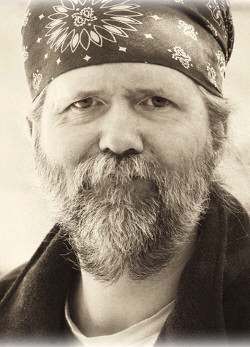 Raphael Adley class of 1980 died February 25, 2022 of unknown causes. He was living in South Lansing at the time of his death. Raphael was preceded in death by his parents and had no siblings.
Raphael Adley class of 1980 died February 25, 2022 of unknown causes. He was living in South Lansing at the time of his death. Raphael was preceded in death by his parents and had no siblings.
Thank you to Cameron Williams class of 1981 for notification.
From BoardGameGeek.com:
Raphael Adley (born 1962) is a game designer who grew up in Okemos, Michigan. He was the only son of an English father and Australian Mother. His Father, James is a renowned artist and was an art professor at Michigan State University. Raphael graduated from Okemos High School in 1980, where he unsuccessfully ran for class president in his junior year.
Raphael has always been an avid game designer; he has designed dozens of games for his friends, but Riot! was the only one published.
Raphael graduated from Michigan State University with a degree in Political Science in 1984. He later ran for County Commissioner of Ingam County Michigan, but was soundly defeated. He has hosted shows on Public Access Television ("Rappin' with Raf" and "The 666 Club").
He has been living in Lansing Michigan, where he enjoys writing and playing games with a large group of friends.
From Thorin Teague to Facebook group C.A.R.P. (Capitol Area Role-Players:
"Rest in Peace Raphael Adley,
Today my community and my family lost a dear friend in Raphael "Raif" Adley. We are still determining the full breadth of the hole his passing will leave in our lives. Raif a board game designer and enthusiast brought many players together, and for some (including members of my family) his games were their main source of socialization. Numerous people are blessed to have fond memories of time spent with Raif. It is my hope that his life has inspired others to carry the tradition of inclusion into gaming even when it is not easy. Players may be difficult, or disruptive, but that is just one more challenge to win."
BENTON HARBOR (A POEM)
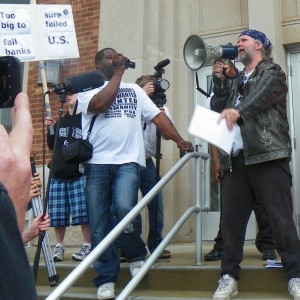
- Raphael Adley reads his poem on the steps of the Benton Harbor city hall May 26, 2012.
By Raphael Adley
Whirlpool, what a Wac company
Whirlpool, it’s a natural catastrophe
Whirlpool, it drags you under the sea
what they do to Benton Harbor they can do to you and me.
What have they done to your city?
they took your jobs but not your dignity
your elders sent to rot in prison
they mock his word but he is risen
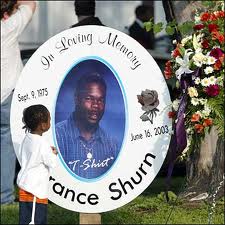
Terrance Shurn was murdered by BH police in 2003, sparking days of rebellion by the city's youth.
your young lay bleeding in the street
they laugh now but the story’s incomplete
they blindly take what Lincoln restored
we shall not rest while rights are ignored
and its all because of (repeat chorus)
While one amongst us is not free
with no justice no peace can be
they stole your park a golf course to make
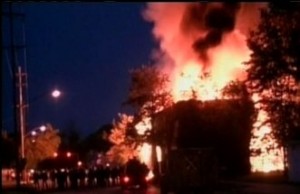
Benton Harbor rebellion against police murder of Terrance Shurn, July, 2003
I WANNA SEE EVERY STUPID GOLF CART SIX FEET IN THE LAKE
police and judges and EFM
a conspiracy of terror it’s us vs them
they plotted in darkness but their cover is blown
thank you Rachel Maddow, they will reap as they’ve sown.
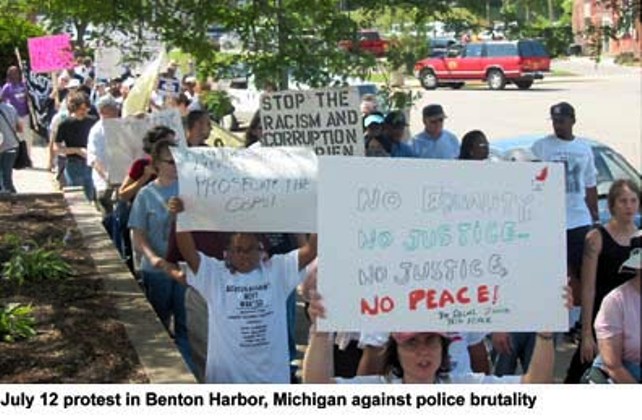
Benton Harbor march July 12, 2003, in support of youth rebellion against police murder of Terrance Shurn/Photo:WSWS.org
Published 1979-10-23 LSJ 28 National Merit Scholarship semifinalists
28 seniors make it to Merit semifinals Twenty-eight local high school seniors have been named as National Merit Scholarship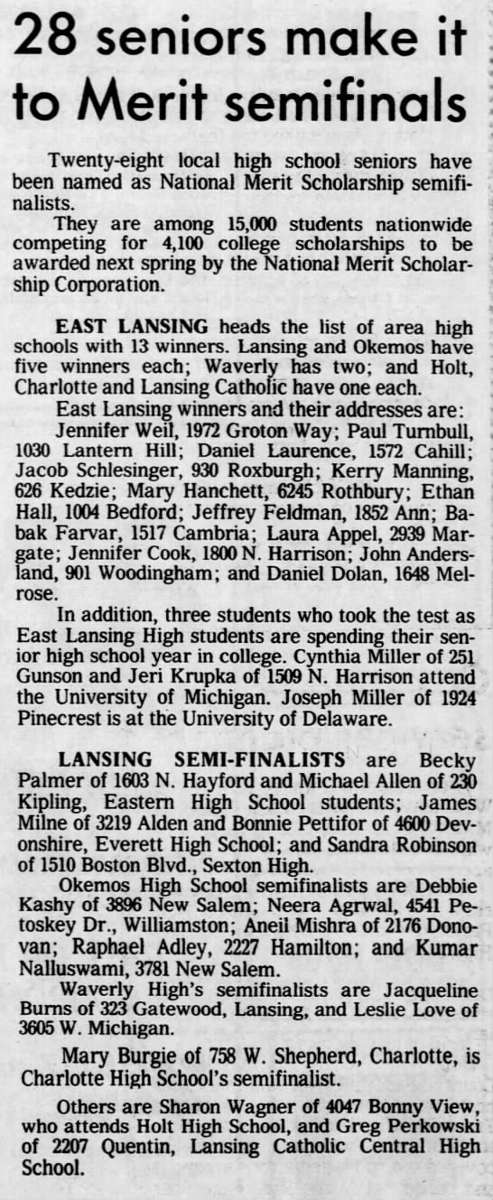 semifi-nalists.
semifi-nalists.
They are among 15,000 students nationwide competing for 4,100 college scholarships to be awarded next spring by the National Merit Scholarship Corporation. EAST LANSING heads the list of area high schools with 13 winners. Lansing and Okemos have five winners each; Waverly has two; and Holt, Charlotte and Lansing Catholic have one each.
East Lansing winners and their addresses are: Jennifer Weil, 1972 Groton Way; Paul Turnbull, 1030 Lantern Hill; Daniel Laurence, 1572 Cahill; Jacob Schlesinger, 930 Roxburgh; Kerry Manning, 626 Kedzie; Mary Hanchett, 6245 Rothbury; Ethan Hall, 1004 Bedford; Jeffrey Feldman, 1852 Ann; Ba-bak Farvar, 1517 Cambria; Laura Appel, 2939 Margate; Jennifer Cook, 1800 N. Harrison; John Anders-land, 901 Woodingham; and Daniel Dolan, 1648 Melrose.
In addition, three students who took the test as East Lansing High students are spending their sen-' ior high school year in college. Cynthia Miller of 251 Gunson and Jeri Krupka of 1509 N. Harrison attend the University of Michigan. Joseph Miller of 1924 Pinecrest is at the University of Delaware.
LANSING SEMI-FINALISTS are Becky Palmer of 1603 N. Hayford and Michael Allen of 230 Kipling, Eastern High School students; James.' Milne of 3219 Alden and Bonnie Pettifor of 4600 Devonshire, Everett High School; and Sandra Robinson . of 1510 Boston Blvd., Sexton High.
Okemos High School semifinalists are Debbie Kashy of 3896 New Salem; Neera Agrwal, 4541 Pe toskey Dr., Williamston; Aneii Mishra of 2176 Donovan; Raphael Adley, 2227 Hamilton; and Kumar Nalluswami, 3781 New Salem. Waverly High's semifinalists are Jacqueline Bums of 323 Gatewood, Lansing, and Leslie Love of 3605 W. Michigan. .
Mary Burgie of 758 W. Shepherd, Charlotte, is Charlotte High School's semifinalist.
Others are Sharon Wagner of 4047 Bonny View, who attends Holt High School, and Greg Perkowski V of 2207 Quentin, Lansing Catholic Central High,, School.
Published 05 Apr 1986 LSJ by Corey Williams Lansing State Journal
Crowd asks foundationdivestiture
The message was loud and clear from the 300 protesters who Friday called for the Michigan State University Board of Trustees to pressure the MSU Foundation to divest $500,000 invested in firms doing business in South Africa.
Waving anti-apartheid signs and chanting "MSU, you can't hide, you support apartheid" and "Divest now," the crowd of students, staff and faculty members marched around the MSU Administration Building. Most then filed into the board room for the trustees' meeting.
"This is sending an important message to the foundation and to black South Africans." said Seshi Chonco, who is black and must return to his native South Africa when he completes his studies at MSU.
"For South Africans, it gives them inspiration that they are not battling alone. Itagives great hope that someday we' will have someone on our side, and be liberated."
The protest and march were in recognition of the national protest day for South African divestiture, the anniversary of the assassination of the Rev. Martin Luther King Jr., and because Friday was the day the trustees met, organizers said. "
Things like this protest bring more awareness,", said Frank Beeman, a member of the Com-, mittee Against Racism and Apar-' theid on Campus (CARAC), and director of Intramural Sports and Recreative Services. "Like the civil rights movement, once people become aware of the issues and knowledgeable of the facts, it will not be difficult to decide what course to take.
"My faith in the students and staff and MSU is again Justified in terms of concerns for the issues."
While dark clouds threatened rain that never fell, the numbers of demonstrators grew minute by minute.
"Apartheid is wrong and we shouldn't be supporting it." said Don Hargraves, as he carried a sign reading; "No to apartheid. MSU Foundation out of South Africa." "The foundation may not change their policy immediately, but if we put on enough pressure they should." Raphael Adley described the large wooden cross he and some friends were carrying as representing dead freedom fighters in South Africa. '
"We want people to know what is going on over there," he said. "Every day people die. and the South African government wants people to believe it is blacks killing blacks when, in reality, it isn't."
In December, the foundation adopted a policy requiring companies to adhere to the Sullivan principles of equal pay and equal opportunities for blacks in South Africa, policies many people feel are Ineffective.
Joseph Dickinson, MSU Foundation president, said he had no knowledge the protest would occur until Thursday night.
"The students were organized and presented their case very well," he said. "I doubt if it makes us change our policy, because the foundation doesn't report to this board. Four of the trustees sit as members of the foundation's board, but they don't report to us, and we don't report to them." William Derman, a CARAC member and professor of anthropology and African studies, said he was surprised to see the difficulty in getting the foundation to follow the board's 1978 decision, as well as the state law calling for divestment.
"Divestiture offers one of the few possible steps to hasten the end of apartheid and give equal political rights to black South Africans." he said. "We ask the board to exercise real authority and responsibility to see that the foundation is in compliance with the divestiture policies on South Africa and act immediately."
In a speech to the board, Chonco said to speak openly against his homeland's apartheid policies is considered treason, and could land him in jail for the rest of his life. .
"I am prepared to suffer in the name of dignity, pride and respect," he said. "I'm not worried. It's a hard price to pay for freedom. So many people are dying at home, sacrificing their lives, freedom and education. Who am I to get worried when there are so many people sacrificing themselves in South Africa?
"Investing in South Africa is like investing in Nazi Germany. The foundation's failure to divest makes a mockery of the Board of Trustees' efforts to divest MSU alumni in Africa are shining stars. Why let such an excellent record be tampered with? We want to be free. Please make it easy and peaceful."
Foundation officials said they plan to discuss all requests for divestment at a finance committee meeting next week.
Published 22 Oct 1986 LSJ by Sheila Schimpf Lansing State Journal
East Lansing defers action on noise, civil rights laws
The East Lansing City Council deferred action Tuesday on amendments to add more enforcement powers to the city noise and civil rights ordinances.
Several Michigan State University students spoke against increasing fines for noise violations, and several homeowners spoke in favor of it.
"Our music is loud and offensive and political," said Raphael Adley, a member of the Army of God band. "We don't want trouble. We just want to entertain. This is chipping against our First Amendment rights."
Two representatives of the Off Campus Council of the Associated Students of MSU spoke against the ordinance, calling it unduly harsh and punitive.
Long-time neighborhood residents urged the council to do something about the noise problem, which one woman said kept her up until 3:20 a.m. last weekend. Other residents said students are frequently the victims of noise violations and tougher standards would protect students as well as permanent residents.
Some asked council to consider solutions other than increased fines. Council agreed to meet with representatives of ASMSU before its next meeting to discuss alternatives.
The new Civil Rights Ordinance, which gives the city Human Relations Commission broader enforcement powers, was deferred to allow the council to look at some suggestions made by the city attorney.
Published 10 Dec 1986 LSJ by Mike Gallagher, Lansing State Journal
Parody of 700 Club stirs fuss
A controversial locally produced cable program that pokes fun at the nationally syndicated 700 Club religion show has drawn both ire and approval of area cable watchers.
The "666 Club" includes profanity, punk bands and religious jokes. The name is a satanic reference taking-off on the 700 Club's religious theme, said the program's producer Raphael Adley.
The 700 Club is hosted by presidential hopeful Pat Robertson.
Officials of Continental Cablevi-sion, 333 N. Washington Square, which broadcasts the 666 Club over Channel 36, said Tuesday they have received complaints about the program's content
Locally produced cable shows are screened to see if they meet cable television criteria, said Michelle Bowers, Continental's programming department manager. The rules prohibit advertisements, obscene language or indecent material.
"I know a lot of people think the 666 Club is obscene, and we have not been particularly happy about it (the show)," Bowers said. "We started getting complaints since it started airing Nov. 1."
Bowers said Continental officials soon will be reviewing the program to determine if it meets broadcast requirements.
"One of the reasons I believe we have gotten complaints is that Lansing is a fairly conservative community," Bowers said. "Also, the 666 Club was shown .right around some church shows.'
Adley, 24, a member of the punk-rock band Army of God,said he decided to produce the 666 Club to provide an outlet for area counter-culture bands, poets and other creative people.
"As far as the 666 Club is concerned, I'm working on a disclaimer with Tom (Hayhoe) that will run at the beginning of the show that will say something like 'this program may contain material that may be offensive to some people," Adley said.
Hayhoe is Continental program coordinator.
The show has received very little attention since it began airing earlier this year on WELM-TV, where it has been shown in the East LansingMeridian Township area, Adley said.
Adley said he can understand some of the negative response to the half-hour program, which usually is broadcast at night
"Some of the show is offensive, I'll admit that" he said. "But the primary goal is for originality. We even make a conscious effort to get Christian bands on. The Satanic parody is just that I don't think any of us are really satanists."
Hayhoe said he believed complaints would be raised after seeing the first 666 Club show.
"We have one person who works to review the programs that come into us," Hayhoe said. "But we are unable to review most tapes that come in. It's not Continental's job to accept or not accept anything.
"If we get complaints we look Into it right away, and that's what we'll be doing with the 666 Club show," Hayhoe said.
Bowers agreed. "Considering we're a media and available to the general public, we are not going to censor ideas. We may offer suggestions on how to present those ideas. But we can't tell them what they can say or censor their programs."
Jim Mason, director of public access at WELM-TV Cable 11, which offers its facility for taping and production of the 666 Club show, said he suggests people who find the program offensive "should just turn the channel."
"Quite honestly the only calls I have received are from the show's regular viewers. It has quite a good following in the area. When we preempt the show for something else they call us."
Mason said WELM-TV offers free training and equipment that persons can use to produce their own shows which then may be aired by cable companies.
"We are not in the business of deciding what their content should be," Mason said. "The FCC never sends anyone in to check our programs. When you start monitoring what goes over the air on a case-by-case basis, it smacks of censorship. It's a very touchy subject. We carry anything anyone wants.
"If someone has a program that doesn't jibe with 80-90 percent of the community, we try not to keep these people from making their point" he added.
Published 14 Dec 1986 LSJ by Mike Gallagher, Lansing State Journal
Complaints to Continental Cable will push '666 Club' to later hour
A local cable television company has decided to air a controversial religious-parody program later at night because of recent complaints.
An official of Continental Ca-blevision, 333 N. Washington Square, said the company will continue broadcasting the "666 Club" on Channel 36. The program includes profanity, punk bands and jokes aimed at religion.
The show's name is a satanic reference taking off on the nationally syndicated 700 Club religion program, according to 666 Club producer Raphael Adley.
Michelle Bowers, Continental's programming department manager, said she has received several complaints about the show's con- te "Under federal rules we can't cancel the program," Bowers.
"Under federal rules we can't cancel the program. We've reached an agreement with the producer to run the program later at night." Michelle Bowers, Continental Cablevision programming department manager said. "We've reached an agreement with the producer (Adley) to run the program later at night"
Bowers said the 666 Club is slated to run Thursday nights at either 10 p.m. or 10:30 p.m.
Adley said he has no problem with the different time slot and admitted that "most people will find the show offensive."
However, Adley quickly added, "the primary goal is for originality. We even make a conscious ef fort to get Christian bands on. The satanic parody is just that I don't think any of us are really satan-ists."
In the Book of Revelations "666" is the number assigned the Antichrist."
Adley said he began producing the show at WELM-TV Cable 11, 1070 Trowbridge Road in East Lansing, to give counter-culture bands, poets and speakers an outlet unavailable to them in commercial markets.
Published 06 May 1987 LSJ by Peter Sleeth, Lansing State Journal
Skateboarders not flipping for strict proposal
A proposed ordinance to restrict skateboarding in sections of downtown East Lansing drew fire Tuesday at a City Council meeting.
A public hearing has been set for May 19 at the East Lansing Public Library. But that didn't stop skateboard supporters from venting steam Tuesday.
"I'm going to fight you," said Raphael Adley, a member of a local musical group. "Skateboards are not an issue what seems to be lost here is no pedestrian has been hurt or killed."
"I don't think a ban is a real constructive solution," said James Stalker, a college freshman.
The proposal would ban skateboarding in any public parking lot owned or leased by the city. It also bans skateboard use in an area bordered by Abbott Road, Charles Street, M.A.C Avenue and behind the businesses in that area facing Grand River Avenue.
The section, one of the most congested areas of East Lansing, frequently is visited by skateboarders. The area is bounded by public parking lots and private businesses.
Skateboard activity has brought complaints from business owners concerned about the protection of their property and the safety of their customers.
The ordinance also would require skateboarders to yield the right-of-way to pedestrians and force the city to put up signs designating which areas are out of bounds for skateboards.
It would be a civil violation, similar to a traffic ticket, to violate the law. The penalty would be a fine of not less than $5 and not more than $20.
Mayor John Czarnecki said the city would explore the idea of a skateboard park to alleviate the problem.
"If there is no major cost from a liability standpoint, I'm willing to consider that," he said. "It looks like skateboarding is here to stay."
Published 03 Feb 1991 LSJ

Published 13 Oct 1992 LSJ - Candidate for Meridian Parks Commissioner
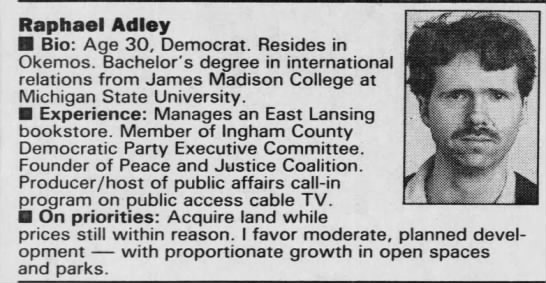
Published 16 Oct 1993 LSJ by Dana Yvette George, Lansing State Journal, photo Chris Holmes
 Mark Parker (left), Raphael Adley and others protest the American involvement in Somalia. Parker and Adley are from Lansing, but other protesters are from as far away as Detroit and Flint.
Mark Parker (left), Raphael Adley and others protest the American involvement in Somalia. Parker and Adley are from Lansing, but other protesters are from as far away as Detroit and Flint.
Protesters sound off on Somalia
Young area residents and students carried signs Friday saying "The yellow ribbon is soaked in blood" to protest U.S. involvement in Somalia.
About two dozen protesters from Lansing, Okemos, Flint and Detroit gathered at the state Capitol.
About 1,000 U.S. ground troops will go to Somalia under orders by President Clinton. This is in addition to the 1,700 soldiers
Clinton announced last week that he would TROUBLED rs soyo send. Overall, about 20,000 U.S. troops will be in Somalia. Clinton promised to have all troops out of Somalia by March 31.
"Do peacekeepers fire on unarmed women and children? In June they did, killing 20," said a sign carried by Lansing Community College student Steve Gonzalez, 17.
Many protesters said U.S. officials claim to be intervening in the name of democracy, but are actually involved because of oil located there.
"I think the U.S. government goes on these missions in the name of democracy or humanitarian issues, but in reality it's in the interest of business. When things became chaotic, the oil companies had to leave. That's when the U.S. stepped in," Gonzalez said.
After about a half-hour of protest. State Police officers told the group to leave state property because it didn't have a protest permit
The group then took the protest to the streets, walking downtown on Michigan Avenue and Washington Square. Protesters chanted and beat drums, tooted horns and chimed bells.
Downtown shoppers glanced up at the banners with curiosity and read the signs out loud. Some drivers honked their horns and gave thumbs-up signs.
"U.S. bloody hands off Somalia, Haiti, Bosnia, Iraq, Peru, South Korea," said a sign carried by Raphael Adley, 32, of Okemos.
"I want the U.S. troops out. U.N. forces too," Adley said. "They've gone way beyond the humanitarian patrol. It's become a political mission to take Somalia out of the hands of the people."
Published 15 Jul 1994 LSJ Candidate for Ingham County Commissioner
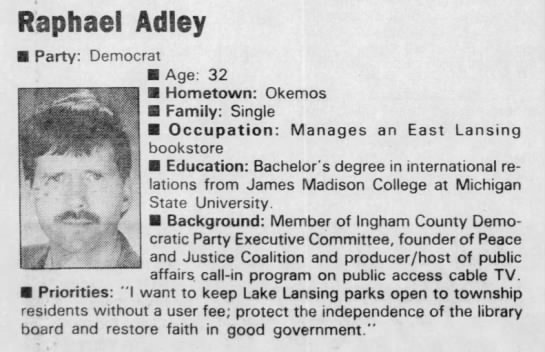
RESULTS
In District 6, Laura Appel won the Democratic race with 1,632 votes, to Raphael Adley's 504. Incumbent Republican Tom Wilbur won with 815 votes, to Thomas Wazny's 751.
Published 23 Mar 2012 LSJ by Scott Davis sedavislsj.com
Occupy Lansing weighing camp revival
The Occupy Lansing group may be coming out of hibernation with this week's warm temperatures. Members will meet at 1 p.m. Saturday for a picnic at Reutter Park to discuss whether to revive the camp that disbanded in December.
"A main goal will be to assess how many members are interested in camping this year in the downtown Lansing park", said Raphael Adley, a member of Occupy Lansing. The public is invited to attend the event, which will last until dusk.
Occupy Lansing formed last year amid a nationwide protest spawned by Occupy Wall Street, a New York group that protests social and economic inequality, including what it viewed as corporate greed.
Adley, who camped in the park after the local group formed in October, said he will be pushing to re-establish the camp. He and other supporters see the encampment as a key part of the group's identity - both locally and with the national movement.
The camp disbanded partly due to the freezing cold, but the group has continued to meet weekly at another site. It has staged two rallies in recent months, including one at the Capitol that protested Gov. Rick Snyder's State of the State speech Jan. 18.
"We want to get it into high gear," Adley said. "I believe that the symbol of being in a public occupation will galvanize support for the movement and give us more visibility."
Occupy Lansing also has set priorities this year that include protesting the state's emergency manager law and staging rallies to support homeowners fighting foreclosure.
Under a waiver granted by the city, Occupy Lansing members set up tents in the park in October.
Randy Hannan, chief of staff for Mayor Virg Bernero, said the city has not yet made a final decision on whether to extend a waiver to the group to allow it to camp there this year. City officials are concerned about the safety of camp residents and the cost of allowing the camp to operate.
Hannan said it cost about $10,000 for the city to provide services, including portable toilets for campers, periodic fire safety inspections and cleaning the site after campers left in December.
Published Design & Art Australia Online regarding Raphael's mother, Alison McMaugh
Alison McMaugh b. 1928-2005
From ArtCritical.com 07 May 2015 regarding Raphael's father, James Adley:
ARTWORLD  TRIBUTES
TRIBUTES
Thursday, May 7th, 2015
Grand Symphonic Paintings: James Adley, 1931 to 2015
 James Adley, Helios, 1980s, in the collection of Michigan State University
James Adley, Helios, 1980s, in the collection of Michigan State University
James Adley, who died last month at 83, was one of a generation of British artists who came of age when what came to be known as Abstract Expressionism was first shown on a large scale in London. The impact especially of “The New American Painting” at the Tate in 1959 was huge, not only on art students but in inspiring a commitment to art for someone like myself who had not yet made a career choice; or for Jim, at that time working as an accountant, but who dreamed of a life in music. Our idea of modern painting were the works of Picasso, Klee, Kandinsky, Mondrian – generally available in reproduction as well as the occasional Tate show – and of younger artists like Nicolas de Stael and Pierre Soulages whose work could sometimes be seen in the Bond Street galleries. None of these pictures could have prepared us for the impact of the 1958 Tate show.
The exhibition included works by 17 artists — Pollock, Still, Kline, de Kooning, Motherwell — all the big names, and some lesser ones, but not Reinhardt and I think Hofmann. These paintings were vast, completely occupied one’s field of vision, yet seemed to address themselves to the individual viewer: public in scale but personal, even intimate in address. The surfaces, the paint handling, seemed raw, physical, not cooked up, challenging the eyes, even the body. There was no distance in this work, its drama and immediacy seemed unlike anything in art since Caravaggio. No doubt I exaggerate the radical nature of these paintings because of their effect on me and other young artists such as Bert Irvin (who also died recently) and Basil Beattie. And on Jim Adley, who I didn’t meet until I came to the US in the late ‘70s. Every young artist has to be excited by the heroes of a previous generation. But there was something about the Tate exhibition, reinforced by individual shows at the Whitechapel Gallery of Pollock, Rothko, and others, that had an immediate and dramatic effect on British art. By contrast Abstract Expressionism had already been absorbed in New York; its influence was dominating the more progressive American art schools. American students I knew, like Ron Kitaj and Phillip Morsburger, chose to use their GI Bill benefits to study at the very traditional Ruskin School of Drawing in Oxford to get away from it
As a child Jim experienced the worst of the Blitz in London, and an almost as traumatic evacuation to the country, while his parents stayed on amid the destruction. He found refuge in music, took violin lessons and immersed himself in the study of classical music, which remained a lifelong passion and about which he was extremely knowledgeable. After leaving school he did his compulsory National Service in the RAF, where his skill with numbers earned him a posting to an experimental rocket program in North Wales. Later in life, he would describe the excitement of seeing the night lit up by the explosions and vapor trails of the weapons being tested, and how, looking back, that was the first intimation of an art that could fill the sky (or at least the visual field). After the Royal Air Force, he enrolled in an accountancy program and was soon earning a living that way. He may already have been doing some painting on the side, but music was his main preoccupation (And both music and numbers, in the suggestion of horizontal musical scores, or of mathematical grids or matrices, continued to haunt his painting throughout his career). So, after a few years making a living in the real world, he happened on the exhibition at the Tate. Of all the work there, the strongest, starkest, most dramatic impact was that of Clyfford Still. That was Jim’s experience, and it was mine, too. Not only the paintings themselves, but the memorable rhetoric of the words in his catalog statement proclaiming a new era in art, free of “outworn myths and contemporary alibis.”
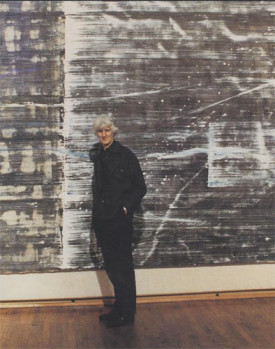 James Adley with his 50 foot painting, Transition, 1988-98, c.1998. Photo: Norbert Freese
James Adley with his 50 foot painting, Transition, 1988-98, c.1998. Photo: Norbert Freese
At the first opportunity Jim resigned his job as an accountant for the Nestlé corporation, and enrolled first at City and Guilds for the year 1959, then at the Chelsea School of Art from 1960-63. However high his ambition, he seems to have been determined to start from the ground up. Images of paintings he did as a student at Chelsea, abstracted still-lives in a painterly Cubist idiom, seem thoroughly competent if not inspired. Certainly not the work of a beginner. Perhaps one can see the influence of the young Australian painter and fellow-student, Alison McMaugh, who had several years experience behind her already. They were married in 1961. Alison was deeply interested in color, in both a practical and theoretical way, and established a solid and consistent career as an abstract painter. They were very different as people, and as artists, but each strongly supported the other over the years, and in what became a difficult and isolated situation in Michigan, and in Arizona where they moved for her health after his retirement from teaching. Her death from cancer in 2005 was, as the saying goes, “a mortal blow” for Jim, from which he never really recovered.
To get back to 1963, Jim’s promise as a painter was recognized by a scholarship to the MFA program at The University of Pennsylvania. Piero Dorazio who was teaching there at the time, had persuaded several of the Abstract Expressionists, among them Motherwell, David Smith, and notably for Jim, Clyfford Still, to visit the program and advise the students. The meeting with Still, and their subsequent conversations (more likely monologues) were for Jim among the most critical events in his life. Still’s example as an artist confirmed Jim in his almost religious devotion to painting (a friend recently described Jim as “the most devoted artist he knew”); but then Still’s bitter and angry denunciations of his fellow artists and the art world in general may not have been so useful for Jim, encouraging him to believe that it was the serious artist’s lot to be misunderstood and rejected anyway, so there was little point to organizing your career in a professional way. Moreover, Jim was completely unlike Still: friendly and open, he had a self-deprecating sense of humor. In his teaching job at Michigan State, which he landed after a single year at Penn and where he taught for the next 30 years, he was loved by generations of students, which earned him the university’s Distinguished Faculty award in 1990. Often in the summers he would bring groups of students to London, and with them visit friends’ studios, both contemporaries and younger artists. In this way he kept open a connection with the London art world that was in many ways closer than that of New York. But he had friends everywhere among artists, critics and museum people — his long letters to friends and even slight acquaintances were prized for their thoughtful observation and knowledge of art and music, with only occasional complaints about the art world’s rejection of abstract painting.
In 1970 he first exhibited in New York, in a group show at the adventurous but short-lived Reese Paley Gallery, one of the first big Soho spaces. Unfortunately it closed before Jim could have his first one person show there — the space would have been ideal for the scale at which he was now working. In the next three decades Jim had one person shows at galleries in Michigan and several university galleries around the US, but New York proved more difficult. During the ‘70s Jim would make an annual trip from Michigan, his van loaded with the previous year’s production of huge canvases on rolls which he would drag into pristine gallery spaces and proceed to unroll on the floor, to the dealer’s evident dismay. By temperament Jim was not the best advocate for his kind of painting, he just assumed that the artists of Still’s generation had established norms for painting in terms of its subject, scale and ambition that would be permanent, not just a phase, a passing fashion. For whatever reason Jim was unwilling or unable to put the time into making adequate images of his paintings. You could not get back far enough in his studio to get a picture without distortion, and even in a large public space the actual visual experience of a 50-foot canvas like Transition (1988-98) was impossible to capture in a slide. Size was a necessary component of his symphonic ambition for painting. He favored a horizontal format with an implied grid or web of vertical and horizontal bars, which could be more or less dominant or transparent, but never rigid or dogmatic and always carried out with delicacy and sensitivity. He worked thin acrylic paint with a variety of implements, including brooms, squeegees and sticks.
In 1977 Jim’s persistence finally paid off, with a one-person show in New York at the Neill Gallery, but that too closed a few years later. A big museum space would have been perfect but was equally elusive: the nearest he came to that was inclusion in a show at the Speed Art Museum, Louisville, in 2001, titled “Imagine: Abstract Paintings from the 1970s.” The only place outside his studio where his work could be seen, and still can be seen, were public buildings for which a painting was commissioned, like Helios in the 1980s, by Michigan State University. Jim had the respect, even the admiration, of some quite well known fellow artists, critics, and museum people, but somehow it never translated into wider recognition. He did win unusually high praise for his work from the Pollock-Krasner foundation, when he won a substantial award in 2005.
Jim’s career recalls that of one of his heroes, the composer Havergal Brian, who after achieving early recognition in the first years of the last century, went on to write 32 symphonies and much other music in complete neglect and obscurity; only three had been performed by the end of his life, when there was a revival of interest in his work. Jim himself flew to England to hear the first performance of Brian’s 7th Symphony in Liverpool in 1987. Like Brian, Jim never stopped working, regardless of the prospects for exhibition, let alone sale, of his grand symphonic paintings. Even in his final years, bedridden and so crippled that he could no longer write, he somehow managed to produce small panels of astonishing freshness and beauty; he was painting until the last week of his life.
A memorial for Jim will be held May 31st at the Kresge Art Center, Michigan State University, Lansing.








 semifi-nalists.
semifi-nalists. 





 James Adley with his 50 foot painting, Transition, 1988-98, c.1998. Photo: Norbert Freese
James Adley with his 50 foot painting, Transition, 1988-98, c.1998. Photo: Norbert Freese
Laurel Winkel (1968)
An afternoon of rememberence April 2, 2022, Lansing, Michigan